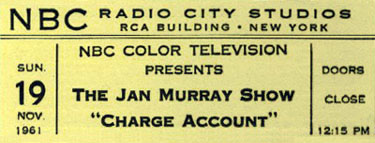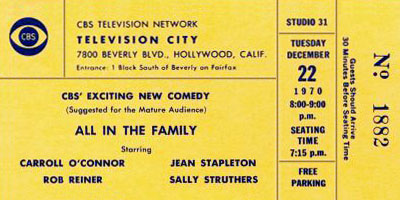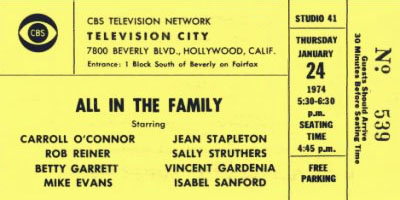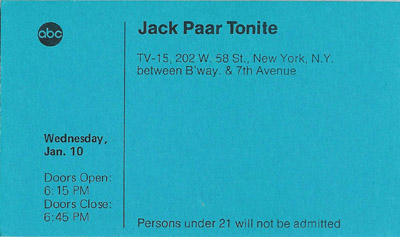Jan Murray Show, The

What we have here is a game show where nobody particularly liked the game. When NBC cancelled Treasure Hunt, it was with the express intention of finding a better vehicle for its host, Jan Murray. He was back in a matter of weeks — as of September 5, 1960 — with Charge Account, a weak game with a good host. So as the months went on, the program became less about winning money and more about Murray chatting with the contestants. In mid-run, it was renamed The Jan Murray Show and by that point, it was at least as much talk show as game. There’d be a fun conversation and then at some point, it would come to a halt and Murray would say, with as much enthusiasm as he could muster, “Well, I guess it’s time for you to win some money.” It was not unlike the way Groucho Marx on You Bet Your Life sometimes treated the quiz part of the show as an intrusion on the entertainment.
Maybe it wouldn’t have been like that if the game itself had been better. Murray would take tiles, each of which had a letter on it, and mix them up in a drum. Then he’d pull them out as if calling Bingo and read the letters off. The contestants had Bingo-style cards in front of them and they’d attempt to form words as they wrote the letters onto their cards. After that, an English professor-type gentleman would grade their cards, awarding them so many points for each three-letter word, so many for each four-letter word and so on. Pretty boring stuff.
All the databases say that it was a half-hour show but I seem to recall either that it ran an hour for at least one week, or that some article said it was going to go to an hour. I also have the vague memory of them dumping the game completely the last few weeks and trying to keep it going as a straight talk show, which is probably what it should have been in the first place.
The “home game” of Charge Account was apparently manufactured to excess: It was well-represented in every toy store and after the show was cancelled, it was possible to buy it, at least in the stores around me, for practically nothing. Which was about what it was worth. Since it didn’t come with the one good thing about the TV show — Jan Murray’s banter — there was no reason to even open the box.
All in the Family



One of television’s most ground-breaking TV shows, All in the Family, debuted on CBS on January 12, 1971…so folks who used the top ticket above to attend a taping had no idea what to expect. The show had been developed for ABC and its pilot was taped twice, both times with Carroll O’Connor and Jean Stapleton in the leads, though with other actors playing the kids each time. When CBS bought the third version of the pilot, the network was in a transition period, dumping shows that skewed older and/or to rural audiences. They were trying to reposition the network for younger, more urban viewers and Norman Lear’s new series was a daring step in that direction.
The show was not an immediate hit. When its early airings were noticed at all, it was to discuss the coarse, bigoted language employed by its central character, Archie Bunker. But CBS stuck with it and audiences discovered it about the time the first thirteen episodes were in rerun. When it was moved from Tuesday nights at 9:30 to Saturday nights at 8:00, it became not only a smash hit but the leader of a new wave of television comedy.
I attended a taping of All in the Family in 1972. What I recall most about the evening was that the warm-up, done by Norman Lear himself, was very long and he kept (a) plucking ladies out of the audience and dancing the tango with them in the aisles, and (b) urging us to watch his new series, Maude. The episode itself had Vincent Gardenia and Rue McClanahan playing a couple that had placed an ad for wife-swapping, and Edith Bunker innocently answered it. Soon after, Gardenia came back as a semi-regular, along with Betty Garrett, while Ms. McClanahan went over to Maude. Before long, there would be other spin-offs, like The Jeffersons, starring Isabel Sanford, Sherman Hemsley and Mike Evans, whose names can be seen on some of the above tickets.
Jack Paar Tonite

In the early seventies, ABC was getting respectable but not overwhelming ratings in late night with The Dick Cavett Show. Some at the network wanted to cancel Cavett and try something else but there was a problem: The show was critically-acclaimed at a time when very little on the ABC schedule was. No one wanted to endure the newspaper editorials and denouncements that would surely come if the network cancelled one of its few respected programs. The answer? The ABC Wide World of Entertainment, a rotating “wheel” of experimental and not-so-experimental programming in what had been Cavett’s time slot. One week a month, it would still be Cavett’s…so it wasn’t like ABC was dumping him; just cutting him back. Two weeks a month, it would be specials, some of which would be pilots for new programs. And the fourth week, it would be the second coming of Jack Paar…back hosting a late night show seven years after The Jack Paar Program (the prime time series he did after departing Tonight) left network television.
Paar’s new show debuted January 8, 1973 to surprisingly little notice. The first broadcast was a particular mess. At the taping, Paar was introduced by his announcer/sidekick Peggy Cass and the host entered to a thunderous ovation and proceeded to do a monologue that had the studio audience in hysterics, Then suddenly, his director (Hal Gurnee, who later gained fame directing David Letterman’s show) stopped the proceedings. There had been a technical snafu: No one had pressed the button to roll tape and they had to start over. Paar fumed, the audience had to pretend to laugh at jokes they’d heard only minutes before…and the show never quite recovered from that.
Later episodes with no technical glitches weren’t a lot better and people who’d heard of Paar but not seen him before got to wondering what was so special about the guy. He seemed out of touch with the current world, dragging out way too many anecdotes about the past. They brought on many of his old guests but the conversations seemed forced and not as wonderful as before. As the whole ABC Wide World of Entertainment tanked, Paar tanked with it. He later claimed that ABC had decided the rotating format wasn’t working and had pressed him to do the show every week instead of every fourth week. This seems unlikely since he was the lowest rated thing in the entire package. (Cavett’s ratings dropped, as well. Audiences just couldn’t get in the habit of following a show that disappeared from the air for weeks at a time. At one point, the legendary comedy writer Jack Douglas, who Paar had engaged to mail in monologue material, sent nothing for a long time until a note arrived. It said, “Sorry I didn’t send anything last week. I forgot you were on.”)
The show went largely unnoticed. On one episode, a young comedian named Freddie Prinze made his TV debut with a solid stand-up comedy routine…but nothing happened to his career. Later that year, Johnny Carson’s Tonight Show booked Prinze, he did just as well there…and became an overnight superstar with offers to headline in Vegas and star in his own TV pilot. Thereafter, Prinze just forgot about Jack Paar Tonite and referred to his appearance with Johnny as his TV debut. No one seemed to notice it wasn’t.
Jack Paar Tonite lasted eleven months before Paar resumed his retirement. He later appeared in occasional specials for NBC and PBS but had the good sense to not attempt another series, despite the occasional offer.






